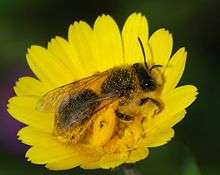Andrena
| Andrena Temporal range: Late Oligocene–recent | |
|---|---|
 | |
| Scientific classification | |
| Kingdom: | Animalia |
| Phylum: | Arthropoda |
| Class: | Insecta |
| Order: | Hymenoptera |
| Family: | Andrenidae |
| Subfamily: | Andreninae |
| Genus: | Andrena Fabricius, 1775 |
| Subgenera | |
| |
Andrena, commonly called the mining bee, is the largest genus in the family Andrenidae, and is nearly worldwide in distribution, with the notable exceptions of Oceania and South America. With over 1,300 species, it is one of the largest of all bee genera. Species are often brown to black with whitish abdominal hair bands, though other colors are possible, most commonly reddish, but also including metallic blue or green.
.ogv.jpg)
Body length commonly ranges between 8 – 17 mm with males smaller and more slender than females, which often show a black triangle (the "pygidial plate") at the abdominal apex. In temperate areas, Andrena bees (both males and females) emerge from the underground cells where their prepupae spend the winter, when the temperature ranges from about 20 °C to 30 °C. They mate, and the females then seek sites for their nest burrows, where they construct small cells containing a ball of pollen mixed with nectar, upon which an egg is laid, before each cell is sealed. Andrena usually prefer sandy soils for a nesting substrate, near or under shrubs to be protected from heat and frost.
Andrena females can be readily distinguished from most other small bees by the possession of broad velvety areas in between the compound eyes and the antennal bases, called "facial foveae". They also tend to have very long scopal hairs on the trochanters of the hind leg.
Species
Partial list of species:
- Andrena angustitarsata
- Andrena agilissima
- Andrena accepta
- †Andrena antoinei Michez & De Meulemeester, 2014[1]
- Andrena auricoma
- Andrena cineraria, Europe
- Andrena fulva, Europe
- Andrena hattorfiana, Europe
- Andrena haemorrhoa, Europe
- Andrena lauracea, known only from 4 specimens in Texas and Illinois, in the central United States
- Andrena salicifloris, western North America
- Andrena milwaukeensis, United States and Southern Canada
See comprehensive separate list.
-

A. accepta
-
_Cumnor.jpg)
A. haemorrhoa, Early mining bee, Oxfordshire
-
.jpg)
A. nida
References
- ↑ Dehon, M.; Michez, D.; Nel, A.; Engel, M. S.; De Meulemeester, T. (2014). "Wing Shape of Four New Bee Fossils (Hymenoptera: Anthophila) Provides Insights to Bee Evolution". PLOS ONE. 9 (10): 1–16. doi:10.1371/journal.pone.0108865.
- C. D. Michener (2007) The Bees of the World, 2nd Edition, Johns Hopkins University Press.
External links
- Andrena, North American species only).
- Andrena miserabilis diagnostic photographs and information
- Andrena Identification Guide (female)
- Andrena Identification Guide (male)
- List of Species
- Worldwide Species Map